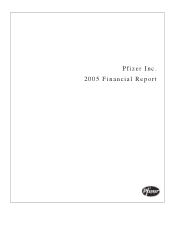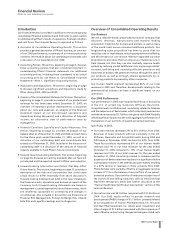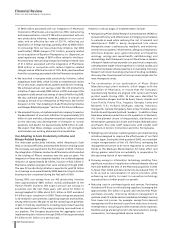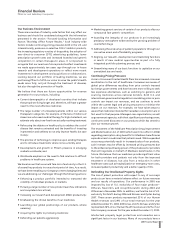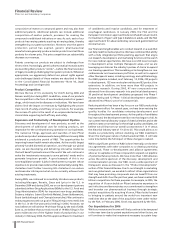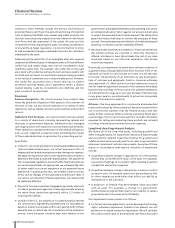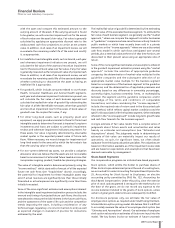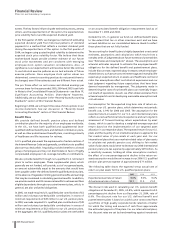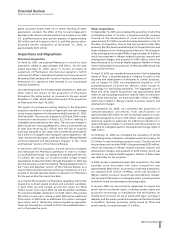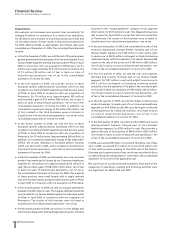Pfizer 2005 Annual Report Download - page 6
Download and view the complete annual report
Please find page 6 of the 2005 Pfizer annual report below. You can navigate through the pages in the report by either clicking on the pages listed below, or by using the keyword search tool below to find specific information within the annual report.
term growth. We remain confident that Pfizer has the
organizational strength and resilience, as well as the financial
depth and flexibility, to succeed in the long term. However, no
assurance can be given that the industry-wide factors described
above or other significant factors will not have a material adverse
effect on our business and financial results.
Given these and other factors, at current exchange rates and
reflecting management’s current assessment, for 2006 we expect
Adjusted income of approximately $15 billion, Adjusted diluted EPS
of approximately $2.00, reported Net income of approximately
$11.4 to $11.7 billion, reported diluted EPS of approximately
$1.52 to $1.56 and over $16 billion in cash flow from operations,
all of which do not reflect the purchase accounting impacts of a
pending business-development transaction, as well as any potential
impacts in connection with a business for which we are exploring
strategic options. We expect 2006 revenues to be comparable to
2005. The growth of three key products—Lipitor, Celebrex and
Lyrica—is expected to contribute significantly to our 2006 revenues.
Our forecasted financial performance in 2006 is subject to a
number of factors and uncertainties—as described in the “Forward
Looking Information and Factors That May Affect Future Results”
section below. Some of these factors and uncertainties may persist
over our planning horizon.
A reconciliation of forecasted 2006 Adjusted income and Adjusted
diluted EPS to forecasted 2006 reported Net income and reported
diluted EPS follows:
($ BILLIONS, EXCEPT PER-SHARE AMOUNTS) NET INCOME(a) DILUTED EPS(a)
Forecasted Adjusted
income/diluted EPS ~$15.0 ~$2.00
Intangible amortization,
net of tax (2.3) (0.31)
Adapting to scale costs(b) (1.4-1.7) (0.19-0.23)
Resolution of certain tax
positions 0.4 0.06
Forecasted reported Net
income/diluted EPS ~$11.4 – $11.7 ~$1.52 – $1.56
(a) Does not reflect the purchase accounting impacts of a pending
business-development transaction, as well as any potential
impacts in connection with a business for which we are exploring
strategic options.
(b) About 15% is expected to be incurred in Selling, informational
and administrative expense (SI&A),about 10% in Research and
development expense and about 5% in Cost of sales with the
balance in Restructuring charges and merger-related costs.
Accounting Policies
We consider the following accounting policies important in
understanding our operating results and financial condition. For
additional accounting policies, see Notes to the Consolidated
Financial Statements—Note 1, Significant Accounting Policies.
Estimates and Assumptions
In preparing the consolidated financial statements, we use certain
estimates and assumptions that affect reported amounts and
disclosures. For example, estimates are used when accounting for
deductions from revenues (such as rebates, discounts, incentives and
product returns), depreciation, amortization, employee benefits,
contingencies and asset and liability valuations. Our estimates are
often based on complex judgments, probabilities and assumptions
that we believe to be reasonable, but that are inherently uncertain
and unpredictable. Assumptions may be incomplete or inaccurate
and unanticipated events and circumstances may occur. It is also
possible that other professionals, applying reasonable judgment to
the same facts and circumstances, could develop and support a
range of alternative estimated amounts. We are also subject to
other risks and uncertainties that may cause actual results to
differ from estimated amounts, such as changes in the healthcare
environment, competition, foreign exchange, litigation, legislation
and regulations. These and other risks and uncertainties are
discussed throughout this Financial Review, particularly in the
section “Forward-Looking Information and Factors That May
Affect Future Results.”
Contingencies
We and certain of our subsidiaries are involved in various patent,
product liability, consumer, commercial, securities, environmental
and tax litigations and claims; government investigations; and
other legal proceedings that arise from time to time in the
ordinary course of our business. We record accruals for such
contingencies to the extent that we conclude their occurrence is
probable and the related damages are estimable. We consider
many factors in making these assessments. Because litigation
and other contingencies are inherently unpredictable and
excessive verdicts do occur, these assessments can involve a series
of complex judgments about future events and can rely heavily
on estimates and assumptions (see Notes to the Consolidated
Financial Statements—Note 1B, Significant Accounting Policies:
Estimates and Assumptions). We record anticipated recoveries
under existing insurance contracts when assured of recovery.
Acquisitions
Our consolidated financial statements and results of operations
reflect an acquired business after the completion of the acquisition
and are not restated. We account for acquired businesses using
the purchase method of accounting which requires that the
assets acquired and liabilities assumed be recorded at the date of
acquisition at their respective fair values. Any excess of the
purchase price over the estimated fair values of the net assets
acquired is recorded as goodwill. Amounts allocated to acquired
IPR&D are expensed at the date of acquisition. When we acquire
net assets that do not constitute a business under generally
accepted accounting principles in the U.S. (GAAP), no goodwill is
recognized.
The judgments made in determining the estimated fair value
assigned to each class of assets acquired and liabilities assumed,
as well as asset lives, can materially impact our results of
operations. Accordingly, for significant items, we typically obtain
assistance from third party valuation specialists.The valuations are
based on information available near the acquisition date and are
based on expectations and assumptions that have been deemed
reasonable by management.
There are several methods that can be used to determine the fair
value of assets acquired and liabilities assumed. For intangible
assets, including IPR&D, we typically use the “income method.”
This method starts with a forecast of all of the expected future
net cash flows. These cash flows are then adjusted to present value
by applying an appropriate discount rate that reflects the risk
factors associated with the cash flow streams. Some of the more
significant estimates and assumptions inherent in the income
2005 Financial Report 5
Financial Review
Pfizer Inc and Subsidiary Companies

